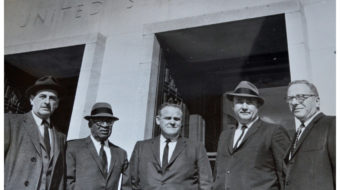DETROIT – As the U.S. economy lurches toward the end of its third year of recession, workers everywhere are struggling to keep ends together, autoworkers no less than anyone else.
Contract talks between the United Auto Workers and General Motors started on July 16, and negotiations with Ford, DaimlerChrysler, and major parts suppliers Delphi and Visteon will follow. The UAW typically focuses its bargaining on a “lead company” to win a contract that sets the pattern for the industry. The 1999 contract expires Sept. 14.
Over the last 10 years, autoworkers have seen a modest increase in wages. While the typical assembler earns about $25.63 per hour, this represents an annual increase of only 1.28 percent since 1992, after adjustments for inflation. While the current contract restored annual increases over the cost of living, workers’ wages are not keeping pace. Workers want a contract that preserves annual wage increases.
Meanwhile, the wages and compensation of the top executives at the auto and parts companies continue to skyrocket. According to the UAW, top executives at these companies received $1.5 million on average last year. The top five executives at GM alone took in $43 million in salary and compensation in 2002. Ford’s former president, Jacques Nasser, took nearly $20 million in his last year, and is still “owed” over $4.5 million.
The average value of bonuses for top executives was over 1,600 times more than the measly $200 average profit-sharing for workers in the Delphi and Visteon plants. It’s the same picture when it comes to pensions and health care: the bosses have no worries, but the workers certainly do.
Now that it is contract time, the Big Three claim that profits have declined from over $18 billion in 1998 to $1.3 billion last year. They and the corporate media blame workers for the losses, although it is clear that huge compensation deals for executives, bad investments (often with pension assets invested in “Enron-type” firms), ballooning health care costs, and the Bush recession are the real underlying causes.
The auto companies tell Wall Street one thing, but workers another. For example, GM has told investment firms that it will sell more cars in 2003 than in 2002, and is predicting increases in profits from its automotive sector. At the same time, the company is handing out late summer production schedules that show increased layoffs. Auto companies play up the strength of their financial positions to investment brokers but talk doom and gloom to the workers.
According to a recent Reuters report, GM may be gearing up for a potential work stoppage. Last spring, GM sold nearly $13 billion in bonds in order to compensate for an increase in pension liabilities. Wall Street investors don’t lend so much money to a company that is supposed to be doing so badly.
At the same time, in early July, company executives announced they won’t make payments on the pension bonds until after the contract negotiations. This suggests that they are stockpiling cash in the event of a work stoppage.
But that is not all they are stockpiling. While production schedules seem to be easing now, GM has been increasing its inventory of vehicles since January. The plan is to build an inventory in case production stops altogether this fall. They want to be able to cushion themselves in the event of a strike.
Higher inventory and the extra cash on hand allow the auto executives greater leverage during the talks. They are quietly saying to the union, “You’d better not go on strike. We can survive.” If true, their financial scheme is an attempt to influence the outcome of the current negotiations.
With nearly $800 billion in combined assets among the five companies bargaining with the UAW this summer, the workers’ demand to “open the books” remains as pertinent as ever.
The author can be reached at jwendland@politicalaffairs.net









